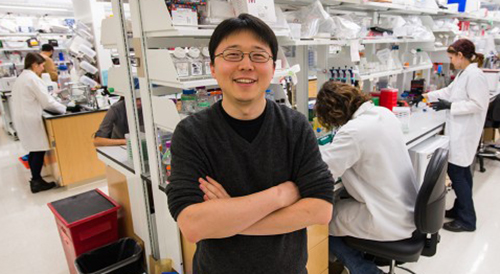Three innovative technologies utilizing CRISPR-Cas13, Cas12a, and Cas9 demonstrate how CRISPR might be used for more than gene editing, while highlighting potential to develop new diagnostics for both the medical laboratory and point-of-care (POC) testing markets
CRISPR (Clustered Regularly Interspaced Short Palindromic Repeats) is in the news again! The remarkable genetic-editing technology is at the core of several important developments in clinical laboratory and anatomic pathology diagnostics, which Dark Daily has covered in detail for years.
Now, scientists at three universities are investigating ways to expand CRISPR’s use. They are using CRISPR to develop new diagnostic tests, or to enhance the sensitivity of existing DNA tests.
One such advancement improves the sensitivity of SHERLOCK (Specific High Sensitivity Reporter unLOCKing), a CRISPR-based diagnostic tool developed by a team at MIT. The new development harnesses the DNA slicing traits of CRISPR to adapt it as a multifunctional tool capable of acting as a biosensor. This has resulted in a paper-strip test, much like a pregnancy test, that can that can “display test results for a single genetic signature,” according to MIT News.
Such a medical laboratory test would be highly useful during pandemics and in rural environments that lack critical resources, such as electricity and clean water.
One Hundred Times More Sensitive Medical Laboratory Tests!
Co-lead authors Jonathan Gootenberg, PhD Candidate, Harvard University and Broad Institute; and Omar Abudayyeh, PhD and MD student, MIT, published their findings in Science. They used CRISPR Cas13 and Cas12a to chop up RNA in a sample and RNA-guided DNA binding to target genetic sequences. Presence of targeted sequences is then indicated using a paper-based testing strip like those used in consumer pregnancy tests.
MIT News highlighted the high specificity and ease-of-use of their system in detecting Zika and Dengue viruses simultaneously. However, researchers stated that the system can target any genetic sequence. “With the original SHERLOCK, we were detecting a single molecule in a microliter, but now we can achieve 100-fold greater sensitivity … That’s especially important for applications like detecting cell-free tumor DNA in blood samples, where the concentration of your target might be extremely low,” noted Abudayyeh.

“The [CRISPR] technology demonstrates potential for many healthcare applications, including diagnosing infections in patients and detecting mutations that confer drug resistance or cause cancer,” stated senior author Feng Zhang, PhD. Zhang, shown above in the MIT lab named after him, is a Core Institute Member of the Broad Institute, Associate Professor in the departments of Brain and Cognitive Sciences and Biological Engineering at MIT, and a pioneer in the development of CRISPR gene-editing tools. (Photo copyright: MIT.)
Another unique use of CRISPR technology involved researchers David Liu, PhD, and Weixin Tang, PhD, of Harvard University and Howard Hughes Medical Institute (HHMI). Working in the Feng Zhang laboratory at the Broad Institute, they developed a sort of “data recorder” that records events as CRISPR-Cas9 is used to remove portions of a cell’s DNA.
They published the results of their development of CRISPR-mediated analog multi-event recording apparatus (CAMERA) systems, in Science. The story was also covered by STAT.
“The order of stimuli can be recorded through an overlapping guide RNA design and memories can be erased and re-recorded over multiple cycles,” the researchers noted. “CAMERA systems serve as ‘cell data recorders’ that write a history of endogenous or exogenous signaling events into permanent DNA sequence modifications in living cells.”
This creates a system much like the “black box” recorders in aircraft. However, using Cas9, data is recorded at the cellular level. “There are a lot of questions in cell biology where you’d like to know a cell’s history,” Liu told STAT.
While researchers acknowledge that any medical applications are in the far future, the technology holds the potential to capture and replay activity on the cellular level—a potentially powerful tool for oncologists, pathologists, and other medical specialists.
Using CRISPR to Detect Viruses and Infectious Diseases
Another recently developed technology—DNA Endonuclease Targeted CRISPR Trans Reporter (DETECTR)—shows even greater promise for utility to anatomic pathology groups and clinical laboratories.
Also recently debuted in Science, the DETECTR system is a product of Jennifer Doudna, PhD, and a team of researchers at the University of California Berkeley and HHMI. It uses CRISPR-Cas12a’s indiscriminate single-stranded DNA cleaving as a biosensor to detect different human papillomaviruses (HPVs). Once detected, it signals to indicate the presence of HPV in human cells.
Despite the current focus on HPVs, the researchers told Gizmodo they believe the same methods could identify other viral or bacterial infections, detect cancer biomarkers, and uncover chromosomal abnormalities.
Future Impact on Clinical Laboratories of CRISPR-based Diagnostics
Each of these new methods highlights the abilities of CRISPR both as a data generation tool and a biosensor. While still in the research phases, they offer yet another possibility of improving efficiency, targeting specific diseases and pathogens, and creating new assays and diagnostics to expand medical laboratory testing menus and power the precision medicine treatments of the future.
As CRISPR-based diagnostics mature, medical laboratory directors might find that new capabilities and assays featuring these technologies offer new avenues for remaining competitive and maintaining margins.
However, as SHERLOCK demonstrates, it also highlights the push for tests that produce results with high-specificity, but which do not require specialized medical laboratory training and expensive hardware to read. Similar approaches could power the next generation of POC tests, which certainly would affect the volume, and therefore the revenue, of independent clinical laboratories and hospital/health system core laboratories.
—Jon Stone
Related Information:
Multiplexed and Portable Nucleic Acid Detection Platform with Cas13, Cas12a, and Csm6
Rewritable Multi-Event Analog Recording in Bacterial and Mammalian Cells
CRISPR-Cas12a Target Binding Unleashes Indiscriminate Single-Stranded DNase Activity
Researchers Advance CRISPR-Based Tool for Diagnosing Disease
CRISPR Isn’t Just for Gene Editing Anymore
CRISPR’s Pioneers Find a Way to Use It as a Glowing Virus Detector
With New CRISPR Inventions, Its Pioneers Say, You Ain’t Seen Nothin’ Yet
New CRISPR Tools Can Detect Infections Like HPV, Dengue, and Zika



